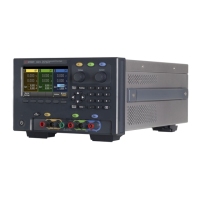You can also connect the Inhibit input to a manual switch or external control signal that will short the Inhibit pin to
common whenever it is necessary to disable all outputs. Negative polarity must be programmed for all pins in this
case. You can also use the Fault output to drive an external relay circuit or signal other devices whenever a user-
definable fault occurs.
Clearing a System Protection Fault
To restore all instruments to a normal operating condition when a fault condition occurs in a daisy-chained system
protection configuration, two fault conditions must be removed:
1.
The initial protection fault or external Inhibit signal.
2.
The subsequent daisy-chained fault signal (which is sourced by the Inhibit signal).
Even when the initial fault condition or external signal is removed, the fault signal is still active and will con-
tinue to shut down the outputs of all the units.
To clear the daisy-chained fault signal if the operating mode of the Inhibit input is Live, simply clear the output
protection on any ONE unit by pressing Source Settings > Protection Clear for all outputs.
If the operating mode of the Inhibit input is Latched, turn off the inhibit input and clear the output protection for all
outputs on ALL units individually. To re-enable the chain, re-program the Inhibit input on each unit to Latched
mode.
Trigger input
Any of the Digital Control pins can be programmed to function as a trigger input. All pins are referenced to the signal
common pin.
To input an external trigger signal, you can apply either a negative-going or a positive-going pulse to the designated
trigger input pin. The trigger latency is less than 450 microseconds. The minimum pulse width is 2 microseconds.
The pin’s polarity setting determines which edge generates a trigger-in event. Positive means a rising edge and
Negative means a falling edge.
You can configure the data logger and the output list to be triggered by external trigger signals. Simply select DIO
Trigger In as the trigger source when configuring the data logger and output list. This will enable input trigger
signals on the configured digital pins. A trigger is generated when an external signal that meets the signal criteria is
applied to any configured trigger input pin.
From the front panel:
1. Press Utilities > I/O Config > Digital IO to access the Digital I/O window.
2. Select the pin you wish to configure. For example, press Pin 1 to configure Pin 1.
3. Press Function and select Trigger In. Select and program the remaining pins in the same manner. Press Back to
return to previous page.
4. Configure the polarity for each of the pin. Press Polarity Pos to select Positive and Polarity Neg to select
Negative. Select and program the remaining pins in the same manner.
Keysight E36300 Series User's Guide 71

